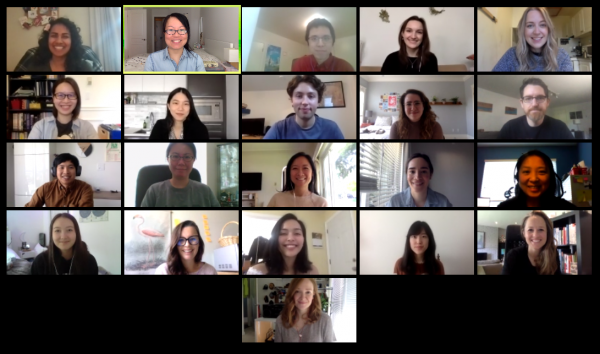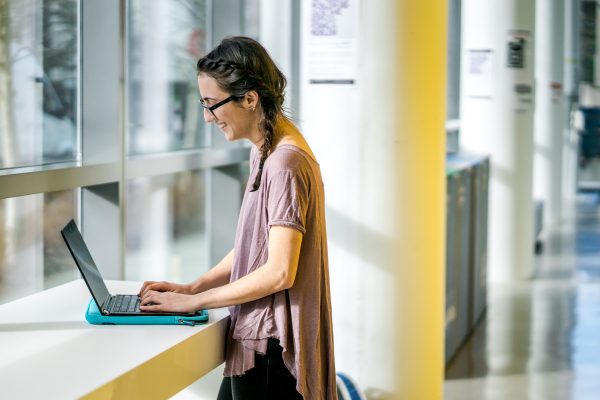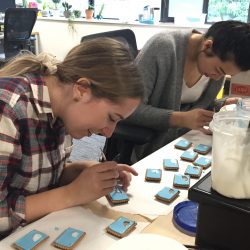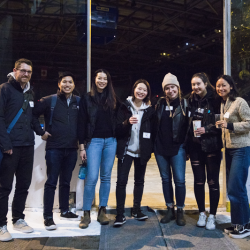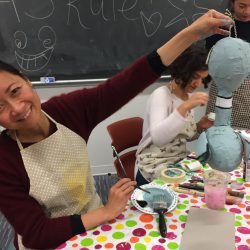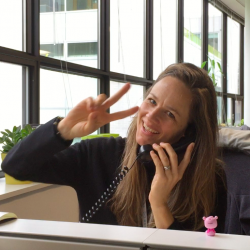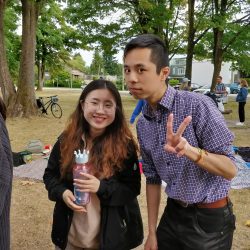Posted on behalf of Vicky Tran, Content and Engagement Strategist
I started working in Student Communications Services (SCS) in December 2015. I’d left a marketing position at a large non-profit and was looking forward to no longer having to ask people for money in as many creative ways as I could muster.
So when new colleagues asked what had drawn me to a position with SCS, it wasn’t hard to answer:
“Philosophically,” and yes, I really did lead with that, “I love what my job means.”
“I love that I’m not asking for money or trying to sell anything to anyone. Instead, my job is all about making students aware of the really great things that they can take advantage of at UBC—because they’ve already chosen to study here.”
“Philosophically,” I couldn’t help repeating, “this really aligns with my values and what I want to do with my energy and time.”
Four and a half years later, I still feel the same way.
Putting students at the centre of what we do

So, what exactly does SCS do?
Bear with me, because I’m going to get philosophical one more time.
I love that ‘students’ is the leading word in our unit’s name, that ‘communications’ is quite literally in the heart of it, and that the idea of ‘service to others’ is implied.
We’re not, in other words, “The Office of Communications with Current Students” (or some other unwieldy administrative title). We’re simply and purposefully “Student Communications Services”.
We’re here to support students by providing the key information and perspectives that can help them navigate the complexities of university life and make the most of their time at UBC.
This means a lot of different things, like making sure that students.ubc.ca has up-to-date info to help students do things like pay tuition or apply for awards and scholarships. It means sharing events and ways to get involved in campus life so they feel like they’re part of a community. It even means publishing student stories on honest and sometimes hard subjects like experiences with academic failure, homesickness, or winter blues, so that students know they’re not alone in whatever they may be going through.
Ultimately, our team is here to advocate for students, to “put them,” as our Interim Director Katja Clark often says, “at the centre of what we do.”
This means striving to share the right information at the right time, and on the channels and in the formats that make the most sense for students (not us). It means advocating for ‘just-in-time’ as opposed to ‘just-in-case’ information, recognizing that students, like us, have burgeoning inboxes and multiple demands on their time.
As one of our designers, Jodie Crocker, sees it:
“We truly try to put students first and give a lot of thought to what they’re going through, how they’ll respond, and what kind of content is important for them.”

A team energized by students and recent grads
What kind of team does it take to deliver student-centred communications?
First, it’s one that’s deeply informed by student perspectives—because it’s impossible to really advocate for students if we don’t know what they’re thinking.
To that end, we have a bunch of current students and recent grads on our team (about 40% of our staff make-up, in fact!). They support critical and diverse functions of SCS, from assessing and improving the content on students.ubc.ca to writing and producing stories for the UBC Life blog and Instagram channels. They’re a continual source of energy and creativity, and, very crucially, they help us stay relevant.
As my colleague, Erin Shaw, a Content & Engagement Strategist, puts it:
“I really enjoy working with students and seeing our work through their (VERY) honest eyes. When things don’t make sense, or we’re not in step with ‘the kids,’ our student staff let us know, and hilarity ensues. For example, I loved working with two of our students on a blog piece called Sex Talk: The (un)official guide to sexual language. I learned SO MUCH VOCAB.”
So did I, Erin, so did I.
A team of many talents (and why we’re like home renovators)
Delivering effective communications to students in a digital age also takes a highly multidisciplinary team.
Now, I could list the different functions on SCS and explain the technical elements of what each does—but what would be the fun in that? 🙂
Let me instead use a metaphor inspired by all the home reno shows I’ve been binging during COVID.
Think about a newly renovated home. Can you picture it? The paint colours, the artwork on the wall, the (as of yet) pristine furniture—these interior details are usually what get the initial attention.
Content like posters, videos, newsletters, and web pages are the eye-catching ‘interior decor’ that often comes to mind when people think of what communications entails. They’re created by talented writers, designers, photographers, and video producers. They’re also shepherded along by dedicated project managers and communications coordinators, and reviewed by keen editors and proofers (no one wants a poster with a typo).
Our team is incredibly lucky to have all these skills in house. It means the content we create never feels like a dated ‘90s kitchen, but is instead fresh, vibrant, and uplifting.
If interior decor makes a space feel warm and welcoming, and gives it personality, how a space is laid out determines whether or not it functions well. That’s where our content strategists, user experience (UX) coordinator, and user interface (UI) designer come in.
They consider how a digital ‘space’ (e.g a website or a form) is navigated by the end user—students. Does the space flow well and enable its residents to complete their tasks—or is, say, the laundry room in such an obscure spot that no one will ever find it? Is the coffee table well-placed or are you going to stub your toe every time you pass it? These are the figurative problems that these sharp folks on our team solve daily.
How a space looks and flows are visible and top of mind. But we cannot forget about the invisible but critical elements of a home, the most important being the foundation.
On our team, ‘foundation laying’ is performed by many functions. I think of our detail-oriented program coordinator and project managers, for example, who make sure we have the supplies, licences, and resources we need on a project, who build sexy spreadsheets and kanban boards to keep everyone on track, and who tackle HR paperwork with gusto to make sure we can bring on student staff at the start of each term.
I also think of our web developers who maintain our websites and applications in a quietly heroic, behind-the-scenes way (sometimes into the wee hours of the night when an outage or some other urgent situation requires it).
Our developers also build the ‘power’ tools that allow our designers to create elements that make a digital ‘space’ even more functional. (I know that sounds a little ‘meta’, so the best analogy I can think of is this: an interior designer can’t order custom-built shelves if the power tools don’t exist for the builder to craft them.)
Another major type of foundational work is performed by everyone on our team who collaborates with partners and stakeholders to define the direction and scope of a project—often our director, strategists, and project managers. This ‘structural’ work involves asking important, hard, and (what can appear to be) pesky questions, such as:
How much time do you have? What is your budget?
What are you trying to achieve? For whom? Why?
What exactly do you want to say? What are your key messages?
How will this matter to students? Why should they care about this thing (event, opportunity, policy, etc.) that you want to communicate? (I told you the questions can seem pesky.)
Like laying a foundation, getting everyone aligned on the exact problem we’re trying to solve (and the best ways to solve it) is hard work, but it’s super crucial—and also rewarding.
As Katja has put it:
“What I find meaningful is getting the right people in a room to work a problem and figure out creative solutions that keep the student at the centre of it. I find it rewarding to look at new ways of thinking about problems and new approaches to solving them, and learning from each other along the way.”
Sparking joy in our comms
So why is putting students at the centre of our communications life-changing?
Because it helps us create content that meets students where they’re at. We don’t always get it right, but we won’t stop trying.
Because it has led to feedback like, “I really appreciate this inclusive [post],” “I feel so much better,” and (my favourite of all), “I really needed this…right now”.
And because when you start with what students need, a lot of the decisions become clearer. Less is often more, and ‘sparking joy’ in communications is as much about deciding what not to say as it is about deciding what to push out.
Student-centred communications is ‘magical’ for me personally because four and half years (and countless long days and late nights) later, I can still say that I deeply believe in the work that we do. Despite the challenges of communicating to such a large and diverse audience—especially during these highly uncertain times—knowing I’m helping students feel prepared, supported, and less alone is the ‘why’ that motivates me to keep pushing on.
And in this, I have great company.
Here’s what some of my colleagues have shared about what they most enjoy about their jobs, what motivates them to keep showing up, and what makes them proud about SCS. Maybe it’ll help you reflect on why your own work matters—to you, your teammates, and the students we collectively serve at UBC.
- “I love that I get to experience first-hand the key messages we share with students (myself included), and to see the lengths to which UBC staff would tirelessly go in striving to foster a campus community where all students feel included.” – Shawn Chang, UBC Life Writer & Content Creator (Work Learn student)
- “Knowing that our work makes a difference in students’ lives. Our team’s commitment to improving experiences across UBC campus and the part I play in that.” – Defne Corbacioglu, Communication Designer
- “Being able to work with the most supportive team! I find my job meaningful as I have the opportunity to learn new skills from other teams in SCS.” – Mariel Dela Cruz, Communications Assistant (Co-op student)
- “The lengths we go to to help each other out. We’ve had to lean on each other often, especially over the past 3 months, and having that level of internal support has been the only constant during this intense time.” – Melissa Huang, Communications Coordinator
- “SCS is an amazing family; everyday, I’m reminded that we are all there to support one another as we serve the greater UBC Community.” – Uma Kugavaratharajah, Program Coordinator
- “We are EXTRA, as you could tell from our Gingerbread Competition entry.” – Ariel Lee, UX Coordinator
- “The fact that the content we produce is for students, by students. It makes what we do feel super authentic.” Hannah Madden-Krasnick, Editorial Coordinator (Work Learn student)
- “Helping people, making things better, and fixing the unfixable!” – Jon Tsang, Content & Engagement Strategist
- “Building tools that enable others to improve their work and help students.” – Sha Xiao, Web Developer
- “How much we care about each other at work and outside of it. Even in these COVID times, we’re still checking in as friends and trying to keep in touch to make this all as close to normal as possible.” – Tiffany Zhong, Designer

